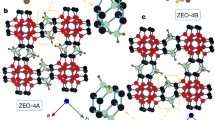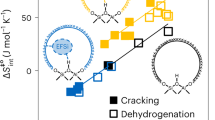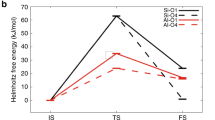Abstract
Crystalline frameworks composed of hexacoordinate silicon species have thus far only been observed in a few high pressure silicate phases. By implementing reversible Si–O chemistry for the crystallization of covalent organic frameworks, we demonstrate the simple one-pot synthesis of silicate organic frameworks based on octahedral dianionic SiO6 building units. Clear evidence of the hexacoordinate environment around the silicon atoms is given by 29Si nuclear magnetic resonance analysis. Characterization by high-resolution powder X-ray diffraction, density functional theory calculation and analysis of the pair-distribution function showed that those anionic frameworks—M2[Si(C16H10O4)1.5], where M = Li, Na, K and C16H10O4 is 9,10-dimethylanthracene-2,3,6,7-tetraolate—crystallize as two-dimensional hexagonal layers stabilized in a fully eclipsed stacking arrangement with pronounced disorder in the stacking direction. Permanent microporosity with high surface area (up to 1,276 m2 g−1) was evidenced by gas-sorption measurements. The negatively charged backbone balanced with extra-framework cations and the permanent microporosity are characteristics that are shared with zeolites.
This is a preview of subscription content, access via your institution
Access options
Access Nature and 54 other Nature Portfolio journals
Get Nature+, our best-value online-access subscription
$29.99 / 30 days
cancel any time
Subscribe to this journal
Receive 12 print issues and online access
$259.00 per year
only $21.58 per issue
Buy this article
- Purchase on Springer Link
- Instant access to full article PDF
Prices may be subject to local taxes which are calculated during checkout



Similar content being viewed by others
Change history
09 May 2017
In the version of this Article originally published, the space group was incorrectly formatted in the third paragraph of page 4, and in the caption of Figure 2. Furthermore, the first sentence of the main text contained typographical errors and has been corrected to read: "In silicate materials, silicon sites almost exclusively adopt a tetrahedral coordination with respect to oxygen and reports of silicon containing hypercoordinate, that is, penta- or hexacoordinate silicon are very rare." Finally, the crystallographic data for the silicate organic framework was not present in the Supplementary Information when this Article was pushed live. These corrections have been made in all versions of the Article.
References
Liebau, F. Structural Chemistry of Silicates (Springer, 1985).
Wagler, J., Böhme, U. & Kroke, E. in Functional Molecular Silicon Compounds I (ed. Scheschkewitz, D.) Structure and Bonding Vol. 155, 29–105 (Springer, 2014).
Rosenheim, A., Raibmann, B. & Schendel, G. Über innerkomplexe brenzcatechinate vierwertiger elemente. Z. Anorg. Allg. Chem. 196, 160–176 (1931).
Flynn, J. J. & Boer, F. P. Structural studies of hexacoordinate silicon. Tris(o-phenylenedioxy) siliconate. J. Am. Chem. Soc. 91, 5756–5761 (1969).
Laine, R. M. et al. Synthesis of pentacoordinate silicon complexes from SiO2 . Nature 353, 642–644 (1991).
Herreros, B., Carr, S. W. & Klinowski, J. 5-coordinate Si compounds as intermediates in the synthesis of silicates in nonaqueous media. Science 263, 1585–1587 (1994).
Kinrade, S. D. et al. Stable five- and six-coordinated silicate anions in aqueous solution. Science 285, 1542–1545 (1999).
Schmiederer, T. et al. The E. coli siderophores enterobactin and salmochelin form six-coordinate silicon complexes at physiological pH. Angew. Chem. Int. Ed. 50, 4230–4233 (2011).
Yaghi, O. M. et al. Reticular synthesis and the design of new materials. Nature 423, 705–714 (2003).
Côté, A. P. et al. Porous, crystalline, covalent organic frameworks. Science 310, 1166–1170 (2005).
El-Kaderi, H. M. et al. Designed synthesis of 3D covalent organic frameworks. Science 316, 268–272 (2007).
Feng, X., Ding, X. & Jiang, D. Covalent organic frameworks. Chem. Soc. Rev. 41, 6010–6022 (2012).
Blake, A. J. et al. Inorganic crystal engineering using self-assembly of tailored building-blocks. Coord. Chem. Rev. 183, 117–138 (1999).
Moulton, B. & Zaworotko, M. J. From molecules to crystal engineering: supramolecular isomerism and polymorphism in network solids. Chem. Rev. 101, 1629–1658 (2001).
Shea, K. J., Loy, D. A. & Small, J. H. Condensed aryl-bridged siliconates. New ladder and network ionomers. Chem. Mater. 4, 255–258 (1992).
Hahn, F. E., Keck, M. & Raymond, K. N. Catecholate complexes of silicon: synthesis and molecular and crystal structures of [Si(cat)2]·2THF and Li2[Si(cat)3]·3.5dme (cat = catecholate dianion). Inorg. Chem. 34, 1402–1407 (1995).
Cella, J. A., Cargioli, J. D. & Williams, E. A. 29Si NMR of five- and six-coordinate organosilicon complexes. J. Organomet. Chem. 186, 13–17 (1980).
O'Keeffe, M., Peskov, M. A., Ramsden, S. J. & Yaghi, O. M. The reticular chemistry structure resource (RCSR) database of, and symbols for, crystal nets. Acc. Chem. Res. 41, 1782–1789 (2008).
Materials Studio Modelling v. 5.0 (Accelrys, 2009).
Mayo, S. L., Olafson, B. D. & Goddard, W. A. DREIDING: a generic force field for molecular simulations. J. Phys. Chem. 94, 8897–8909 (1990).
Grimme, S., Antony, J., Ehrlich, S. & Krieg, H. A consistent and accurate ab initio parametrization of density functional dispersion correction (DFT-D) for the 94 elements H-Pu. J. Chem. Phys. 132, 154104–154119 (2010).
Valiev, M. et al. NWChem: a comprehensive and scalable open-source solution for large scale molecular simulations. Comput. Phys. Commun. 181, 1477–1489 (2010).
Lukose, B., Kuc, A. & Heine, T. The structure of layered covalent-organic frameworks. Chem. Eur. J. 17, 2388–2392 (2011).
Ascherl, L. et al. Molecular docking sites designed for the generation of highly crystalline covalent organic frameworks. Nat. Chem. 8, 310–316 (2016).
Warren, B. E. X-Ray Diffraction (Dover, 1969).
Prill, D., Juhas, P., Schmidt, M. U. & Billinge, S. J. L. Modelling pair distribution functions (PDFs) of organic compounds: describing both intra- and intermolecular correlation functions in calculated PDFs. J. Appl. Cryst. 48, 171–178 (2015).
Prill, D., Juhas, P., Billinge, S. J. L. & Schmidt, M. U. Towards solution and refinement of organic crystal structures by fitting to the atomic pair distribution function. Acta Cryst. A 72, 62–72 (2016).
Hmadeh, M. et al. New porous crystals of extended metal-catecholates. Chem. Mater. 24, 3511–3513 (2012).
Liu, Y. et al. Weaving of organic threads into a crystalline covalent organic framework. Science 351, 365–369 (2016).
Rouquerol, J., Rouquerol, F., Llewellyn, P., Maurin, G. & Sing, K. S. W. Adsorption by Powders and Porous Solids 2nd edn (Academic, 2014).
Acknowledgements
We thank the European Research Council (ERC) for financial support within the project ORGZEO (Grant Number:278593). Support from the German Science Foundation within the Cluster of Excellence UniCat-Unifying concepts in catalysis is further acknowledged. M.J.B. thanks the Czech Science Foundation (GA CR) for junior grant funding (CAMs: 16-21151Y) and the European Research Council (ERC) for funding under the Starting Grant scheme (BEGMAT: 678462). M.J.B. further acknowledges the Charles University Centre of Advanced Materials (CUCAM) (OP VVV Excellent Research Teams, project number CZ.02.1.01/0.0/0.0/15_003/0000417). We thank Professor Holger Dobbek for his precious help, Professor Matthias Driess and Dr Matthias Thommes for fruitful discussions, and Mrs. Christina Eichenauer, Mrs. Maria Unterweger and Mr. Matthias Trunk for their assistance.
Author information
Authors and Affiliations
Contributions
J.R. and A.Th. conceived and designed the experiments. J.R. performed the experiments and carried out the structural characterizations. P.F. and A.Tr. carried out the DFT calculations. D.P. and M.U.S. performed the analysis of the pair-distribution function. A.N.F. collected the synchrotron X-ray diffraction data. M.J.B. refined the high-resolution PXRD data. All the authors interpreted the structures and contributed to the preparation of the manuscript.
Corresponding authors
Ethics declarations
Competing interests
The authors declare no competing financial interests.
Supplementary information
Supplementary information
Supplementary information (PDF 10680 kb)
Supplementary information
Crystallographic data generated for the SiCOF material (CIF 1 kb)
Rights and permissions
About this article
Cite this article
Roeser, J., Prill, D., Bojdys, M. et al. Anionic silicate organic frameworks constructed from hexacoordinate silicon centres. Nature Chem 9, 977–982 (2017). https://doi.org/10.1038/nchem.2771
Received:
Accepted:
Published:
Issue Date:
DOI: https://doi.org/10.1038/nchem.2771
This article is cited by
-
On-surface synthesis of disilabenzene-bridged covalent organic frameworks
Nature Chemistry (2023)
-
Understanding the emergence of the boson peak in molecular glasses
Nature Communications (2023)
-
Stable construction of covalent organic framework/copper sulfide heterojunction on cellulose fibers with hyperbranched polyamide-amine for efficient photocatalytic degradation of organic dyes
Cellulose (2023)
-
Toward azo-linked covalent organic frameworks by developing linkage chemistry via linker exchange
Nature Communications (2022)
-
Constructing ambivalent imidazopyridinium-linked covalent organic frameworks
Nature Synthesis (2022)



